- 1Department of Microtechnology and Nanoscience, Chalmers University of Technology, Gothenburg, Sweden
- 2Department of Physics, Chalmers University of Technology, Gothenburg, Sweden
An increasing number of papers propose routes to implement thermal counterparts of electronic rectification. These schemes are mainly based on combinations of crystal anharmonicity and broken mirror symmetry. With respect to graphene, proposals pivot around shape asymmetry induced by using hetero-structures of nano-patterned or defected sections of pristine graphene. Using Molecular Dynamics (MD) we show that it suffices to split a graphene nano-ribbon into two unequal strained sections using external force which leads to large asymmetry in the forward and reverse heat fluxes. We find that the corresponding rectification ratio is enhanced by up to 60%. Also, and more importantly, the polarity is controllable on-the-fly i.e., by changing the position where the force is applied. Based upon our results we propose a thermo-electric device which obviates the complex nano-patterning and lithography required to pattern graphene every time a new rectification value or sign is sought for, opening a route to simpler fabrication and characterization of phononic phenomena in 2D materials.
1 Introduction
Graphene is currently a prime candidate material for micro-scale and nano-scale heat management applications Cahill et al. (2014) due to its exceptional thermal conductivity Huang et al. (2021); Chen et al. (2020); Pop et al. (2012); Nika and Balandin (2012); Balandin (2011); Li and Zhang (2013). By nanoscale patterning or shaping, the material properties can be tailored to suit particular demands. In the context of thermal transport, this pattering is done to locally modify the phonon dispersion relation Hu et al. (2016) and the corresponding research area, phononics, is sharply on the rise Maldovan (2013); Li et al. (2012). Phononics aims at engineering devices to control transport and detect phonons (heat carriers) in the same way electrons carry information in electronics. Just as the semiconductor diode paved the way for integrated electric circuitry, efforts to construct efficient acoustic and thermal diodes aim at a similar revolution in phononics Maldovan (2013); Zhu et al. (2018); Zhang et al. (2022).
In a thermal diode, or rectifier, the magnitude of the heat flux resulting from a temperature difference applied at the two terminals differ depending on which terminal is the hotter Li et al. (2012); Shih et al. (2015). An important figure of merit is the rectification ratio,
The necessary conditions for a device to display rectification are nonlinearity of the inter-atomic potential and broken mirror symmetry. If this leads to a temperature dependent mismatch of the vibrational density of states (vDOS) between the left and right regions, thermal rectification may ensue. Achieving this condition is easy by attaching two pieces of bulk solid materials with different dependence of their thermal conductivity to the temperature. An example is a junction of bulk pristine crystal to an alloyed or amorphous variant of that in Kobayashi et al. (2009). However, inducing asymmetry and difference in vDOS in the same material needs extra measures. Most proposals relating to carbon nanotubes Wu and Li (2007); Ni et al. (2011), graphene, and other 2D materials have thus so far focused on asymmetry in (a) the number of layers, (b) internal geometry, (c) external or edge shape, (d) material (hetero structure), and (e) asymmetry due to defect i.e., pristine-defective junctions. Implementing heat rectifying devices using the above methods may be very hard to realize, even if it shows promising
Here we show that simply using two weakly connected graphene ribbon segments of unequal length can provide sufficient mismatch of vDOS for significant thermal rectification to emerge. We attribute this to the temperature dependency of the vDOS which emanates from the non-linearity of atomic potentials as well as the length difference which leads to different amount of mechanical strain applied to each section. This will result in different vDOS overlaps for thermal bias in the forward and the backwards directions, which in turn leads to a highly asymmetric flow of heat. Chief among our results is that the rectification ratio and its sign can be adjusted by changing the length of the short and long nano-ribbon sections on-the-fly using electric field-induced strain. An array of electrodes patterned under the free standing graphene controls the point of force application. The point of applying force (strain) acts as the third terminal of the device and causes breaking the symmetry of heat flow. Our proposed principle is akin to applying a normal magnetic field to a two-terminal two-dimensional electron gas (2DEG) device and breaking the time-reversal symmetry and causing non-reciprocity in electric current. The value of
The reported values of
The remainder of this paper is organized as follows. In the next section the molecular dynamics calculations using LAMMPS package and post-processing steps are explained. To demonstrate that thermal rectification can be achieved without detailed nano-patterning, we consider a simple thermal junction composed of a short and a long graphene nano-ribbon connected via a thermal weak link, and review the basic physical explanation of the origin of this effect in terms of temperature dependent vDOS-overlap. Although we can attribute the effect to the behavior of the overlap of the vDOS, we show that the conventional measure of the overlap is here too simple to quantitatively explain the large observed rectification. Thereafter, we present a simplified system made adjustable using an external force due to applied DC voltage. This showcase the role of the third terminal and the mechanical strain which causes symmetry breaking in analogy to the normal magnetic field applied to 2DEG layer. The success of every proposed scheme to achieve heat rectification depends on how much strain is induced in each section of the heat diode. We proved that strain enhances the Umklapp process or down-conversion of phonons and this modifies the low-frequency portion of the vDOS Shiri and Isacsson (2019).
2 Methods
The molecular dynamics simulation is performed using LAMMPS package Plimpton (1995). The graphene nano ribbons are of rectangular shape in zigzag direction and their widths and lengths are (22 nm and 22 nm) and (10 nm and 100 nm), respectively along
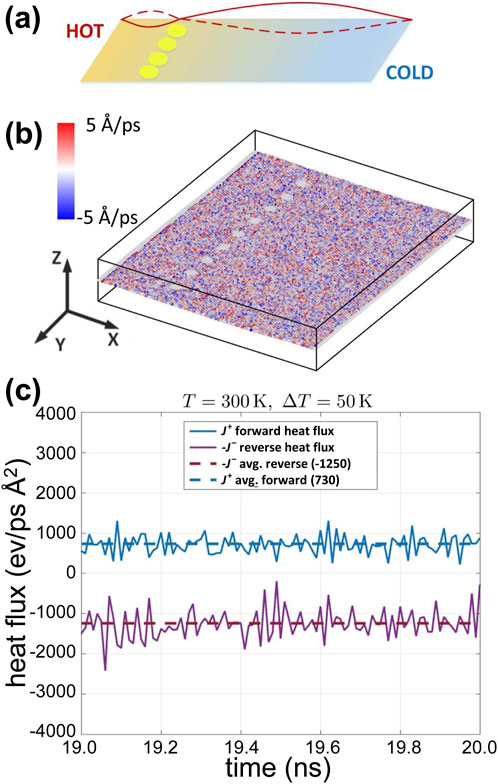
Figure 1. (A) Thermal rectification in an asymmetric graphene junction composed of a short and a long section. (B) Asymmetric junction made from a
For visualizing purposes e.g., viewing the output geometry at each time step, The OVITO package provided by Stukowski (2010) is used. The vibrational density of states of atoms within a region is calculated from velocity auto correlation function (VACF) which is implemented in LAMMPS. The VACF for each region is recorded in the output file for each time step (e.g.,
where
3 Junction thermal rectification
We consider first a simple junction geometry as shown in Figures 1A, B, consisting of a 22 nm × 22 nm graphene sheet clamped at two ends, interrupted by a thermal weak link made from an equidistantly-spaced array of pinned circular regions. Using molecular dynamics (MD), the average heat flux flowing through the structure when the two clamped ends are at different temperatures was recorded.
Prior to imposing pinned sections on the graphene nano-ribbon, the thermal conductivity of the graphene sheet is calculated using Non-Equilibrium Molecular Dynamics (NEMD) Hu et al. (2016) for calibration purposes. Immediately after and before the left and right clamped ends, hot and cold regions are kept at 320 K and 280 K, respectively. Calculating the heatflux
where
Values of
where
Note that the absolute value of thermal conductivity does not matter for study of heat rectification. What matters is the stress-strain relation and how soon or late the applied force leads to asymmetry in the heat flux. Therefore, we speculate that using CH-AIREBO (soft) potential instead of Tersoff (hard) potential leads to down-shift of frequency contents in VDOS, and it should not change the results qualitatively.
Figure 1C shows the result of simulating the phononic junction of Figures 1A, B where the terminals where kept at temperatures
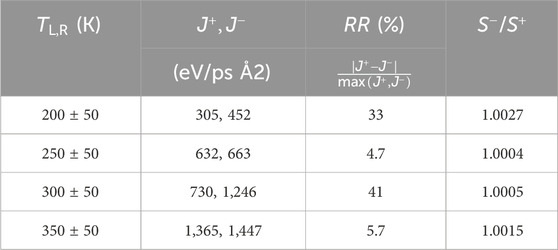
Table 1. Heat fluxes
To understand the mechanism of rectification in this system, it is instructive to first recall the well studied model of a nonlinear one dimensional chain of oscillators connected by an interface layer (or interface bond) Li et al. (2004); Terraneo et al. (2002); Lepri et al. (1997); Yang et al. (2007) which is shown in Figure 2A. If the elastic properties on the two sides of the junction differ, by using for instance different spring constants and different strength of nonlinear potential, as a result the corresponding density of vibrational modes will differ. In the absence of inelastic scattering, the vDOS must have an overlap for phonons to cross the junction. Following the discussion of Benenti et al. (2016) and Li et al. (2004) we consider a system which is composed of two sections modeled as atoms connected by springs, and a Hamiltonian
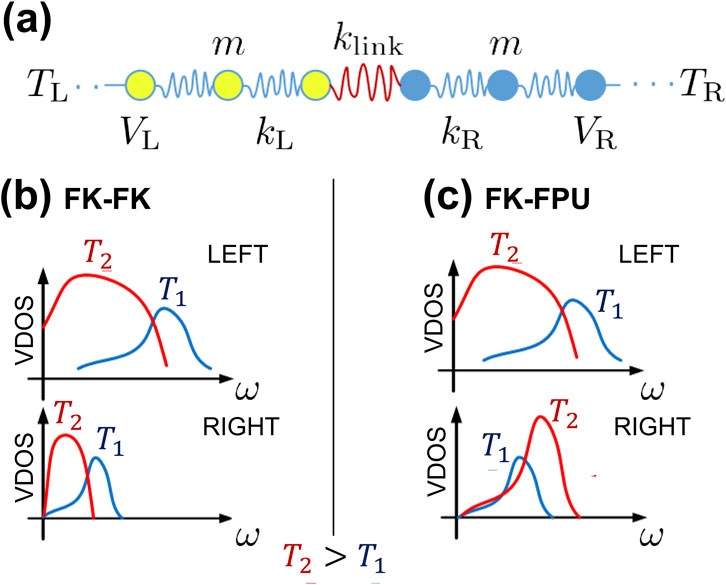
Figure 2. (A) One dimensional model of a thermal junction composed of lattices with different potentials joined by a weak link modelled as a spring with stiffness
Here
Rectifying behavior requires a combination of nonlinearity and broken symmetry. Symmetry breaking is obtained by setting
To enhance the rectification, it is favorable to use hardening and softening potentials on either sides. An example is to replace the FK-potential in the right with a Fermi-Pasta-Ulam (FPU) type system. The nonlinearity in the FPU-
We now return to the 2D-system of Figure 1. We consider the area with pinned circles as the weak link between the left and right sections creating the symmetry breaking. To test if the rectification mechanism is similar to the 1D-systems we have studied the vDOS
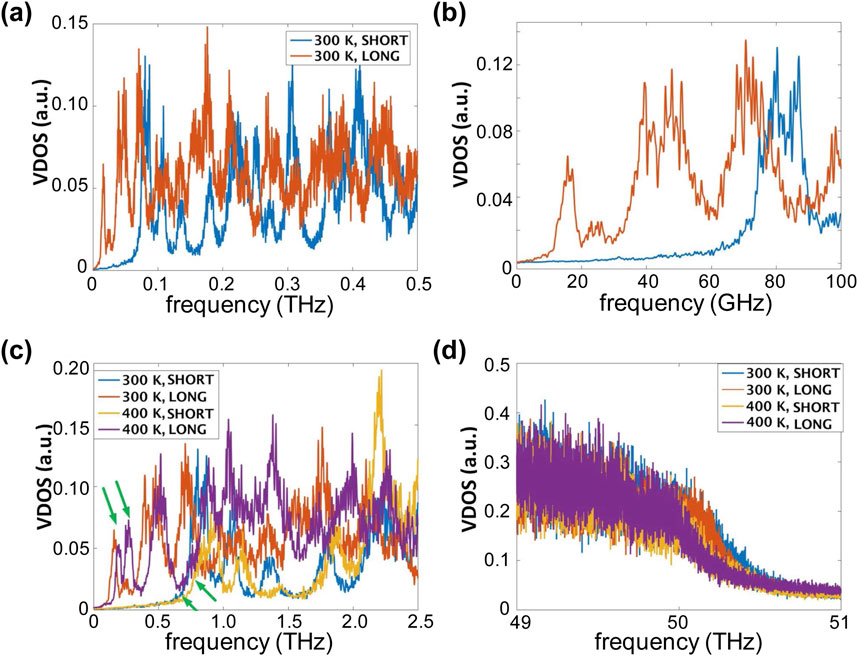
Figure 3. Low frequency density of vibrational states for temperatures of 300 K and 400 K. (A) Spectra for long and short sections of device at 300 K, (B) Magnified section of the spectra shown at (A) for 0–100 GHz frequency range. (C) Spectra for both sections at 300 K and 400 K revealing stiffening of the sections by increasing the temperature which is manifested as frequency up shift (marked by arrows), and (D) the high frequency section of the spectra from 49 THz to 51 THz shows softening of the optical phonon modes, hence a frequency down shift is observed for both sections by increasing the temperature.
First we inspect the low-frequency part of
Figure 3C shows how the acoustic parts of the spectra shifts with changing temperature for both sides. For these low frequency portions of the spectra, increasing the temperature causes blue-shift to higher frequencies, which resembles the way in which FPU-
Although giving little contribution to the thermal transport, the high-frequency part of
As a measure of the degree of overlap, Li et al. (2005) defined a phenomenological quantity
4 Adjustable heat rectification
Based on the above method of dividing a nano-ribbon into a short and long section, we here propose a simpler design with two distinct advantages to other proposals. Instead of partitioning the ribbon in two sections by pinning, we consider applying a force to the nano-ribbon in an asymmetric fashion. The applied force could emanate from sources like mechanical actuation [e.g., piezoelectricity, Atomic Force Microscopy (AFM) tip Hod and Scuseria (2009), Scanning Tunneling Microscopy (STM) tip Neek-Amal et al. (2014)] or electrical force due to an electric field from a local back-gate. The first advantage is that no explicit nano-patterning is needed. The second, and more important advantage, is that changing the position and magnitude of the applied force allow for in situ reconfiguration and control of the rectification.
Specifically we envision a setup here as shown in Figure 4 which is similar to the experimental setup already used to modulate the electron transport properties in carbon nanotubes by Benyamini et al. (2013). Applying electric field to the selected electrode can divide the nano-ribbon into a short and long section. Here a proof of concept molecular dynamics simulation is performed to demonstrate the rectification as a result of force-induced asymmetry.
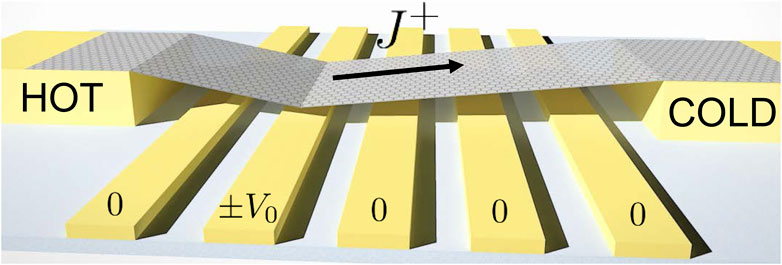
Figure 4. Proposal for a tunable thermal diode where the sign and value of rectification ratio is controlled by applying electric field to the chosen gate electrode underneath a thermally biased graphene nano-ribbon.
Figure 5A, shows a simulation set-up of a 10 nm × 100 nm nano-ribbon, in which a force is locally applied along the
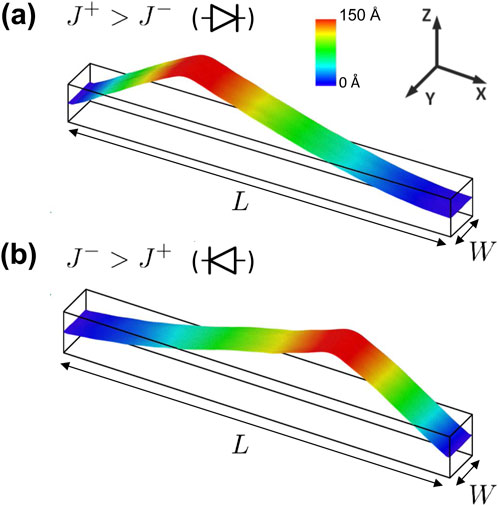
Figure 5. Adjustable heat rectification by asymmetric application of electric field-induced force to a graphene nano ribbon of dimensions
The recorded values of average heat fluxes are shown in Table 2 and they suggest rectification ratios of 35% and 42% for temperature/gradient values of
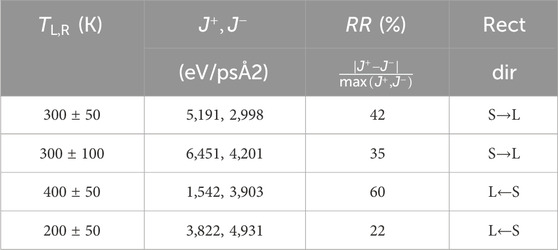
Table 2. Heat fluxes
To verify that the rectification is indeed induced from asymmetric length of the nanoribbon section, we also applied the force symmetrically, dividing the ribbon into two equal partitions. The resulting flux differences for the imposed temperature differences of
In the simulation setup the graphene nanoribbon is periodic along the width direction, which means that changing the width of the nanoribbon does not affect the results. In a real device, the change of width leads to a change of thermal conductivity because phonon branches contribute more to heat conduction. However, in this study, the focus is on effect of asymmetry to rectification, and the absolute value of the thermal conductivity does not matter. However, the change of length needs careful study. For a short nanoribbon, the applied force (stress) leads to larger strain value as both asymmetric parts suffer more length change. For a longer nanoribbon, the same force leads to less deflection and less strain as a result. This means that the same rectification ratio requires more applied force (voltage). With respect to the edge type, it was shown that the zigzag edge along the length of the nanoribbon has more stretchability than the armchair edge. For strain values under 20% the stress-strain plot of graphene is the same for both types of edges, and the difference appears for strain values above 30% in which zigzag shows more robustness. Thus, for a device proposed in our work, if the strain is below 20% both edge types perform equally in terms of heat rectification.
5 Conclusion
Based on molecular dynamics studies of non equilibrium heat transport in graphene nano-ribbons we showed that the thermal rectification ratio can be simply adjusted both in value and sign using a force to divide the graphene into strained long and short sections. Starting from a simple structure in which long and short sections are weakly linked by pinned areas, we showed how this partition lead to the necessary temperature dependent asymmetric vibrational density of states required for thermal rectification.
The importance of this observation and the proposal of Figure 4 is reflected in the simplicity in implementing an in situ tunable heat diode, as exemplified by using an array of local back gates which can selectively induce asymmetric stress in a suspended graphene membrane. Our findings show that the values of heat flux and the rectification ratio can be controlled on-the-fly while the device is operating. Consequently, to achieve rectification it is not necessary to fabricate elaborate asymmetric shapes, i.e., patterning arrays of holes, defects, inducing grain boundaries or the requirement of making a hetero-structure Hong et al. (2016) of pristine graphene with other kinds of graphene [multi-layer Zhang and Zhang (2011); Xu et al. (2014), defected Wang et al. (2012), patterned Yang et al. (2009); Hu et al. (2009); Hu et al., (2017); Wang et al. (2014)], etc. Thus, the combination of simplicity of implementation, and tunability of rectification ratio and sign, opens up for more controlled experiments and developments in the field of 2D-phononics.
Fabricating of gate arrays is a standard process for study of spin-based qubits in semiconducting nanowires and it is CMOS-compatible and is scalable to two dimensions. It was also used to study electron transport in quantum dots formed in a long carbon nanotube [See Benyamini et al. (2013)]. This process is much simpler than creating sophisticated patterns in graphene e.g., arrays of hexagonal holes, tapering the graphene with atom precision, or making graphene multilayer using CNT pillars as proposed in other theoretical works [See Yousefi et al. (2020b); Malik and Fobelets (2022); Zhao et al. (2022)].
In our study the applied voltage (force) is static although the place of the electrode can be changed in situ, however after the things are settled the same static mechanism explained here is valid. We did not study the role of dynamic (time-dependent) forces for example, applied sinusoidal voltage (force) on the heart rectification. As graphene is a nonlinear system, application of an external tone leads to mixing of different phonon modes and generation of different harmonics in VDOS. De Alba et al. (2016) et al. have shown that by applying sinusoidal force using back gate to a graphene disk, it is possible to parametrically amplify or de-amplify a vibrational mode. A recent theoretical study was brought to our attention in which the rectification ratio of 120% is achieved by application of strain gradient to a graphene nanoribbon Sai Kavuri and Sathian (2024).
Data availability statement
The raw data supporting the conclusions of this article will be made available by the authors, without undue reservation.
Author contributions
DS: Conceptualization, Data curation, Formal Analysis, Investigation, Software, Visualization, Writing–original draft, Writing–review and editing. AI: Conceptualization, Formal Analysis, Funding acquisition, Investigation, Resources, Supervision, Writing–original draft, Writing–review and editing.
Funding
The author(s) declare that no financial support was received for the research, authorship, and/or publication of this article.
Acknowledgments
The authors greatly acknowledge access to the Swedish National Infrastructure for Computing (SNIC) and the National Academic Infrastructure for Supercomputing in Sweden (NAISS), partially funded by the Swedish Research Council through grant agreement no. 2022-06725. The computations were also enabled by resources provided by Chalmers e-Commons at Chalmers.
Conflict of interest
The authors declare that the research was conducted in the absence of any commercial or financial relationships that could be construed as a potential conflict of interest.
Publisher’s note
All claims expressed in this article are solely those of the authors and do not necessarily represent those of their affiliated organizations, or those of the publisher, the editors and the reviewers. Any product that may be evaluated in this article, or claim that may be made by its manufacturer, is not guaranteed or endorsed by the publisher.
References
Balandin, A. A. (2011). Thermal properties of graphene and nanostructured carbon materials. Nat. Mater. 10, 569–581. doi:10.1038/nmat3064
Benenti, G., Casati, G., Mejía-Monasterio, C., and Peyrard, M. (2016). From thermal rectifiers to thermoelectric devices. Switzerland: Springer International Publishing, 365–407. doi:10.1007/978-3-319-29261-8_10
Benyamini, A., Hamo, A., Kusminskiy, S. V., von Oppen, F., and Ilani, S. (2013). Real-space tailoring of the electron-phonon coupling in ultraclean nanotube mechanical resonators. Nat. Phys. 10, 151–156. doi:10.1038/nphys2842
Cahill, D. G., Braun, P. V., Chen, G., Clarke, D. R., Fan, S., Goodson, K. E., et al. (2014). Nanoscale thermal transport. ii. 2003–2012. Appl. Phys. Rev. 1, 011305. doi:10.1063/1.4832615
Chen, X.-K., Zeng, Y.-J., and Chen, K.-Q. (2020). Thermal transport in two-dimensional heterostructures. Front. Mater. 7. doi:10.3389/fmats.2020.578791
De Alba, R., Massel, F., Storch, I. R., Abhilash, T. S., Hui, A., McEuen, P. L., et al. (2016). Tunable phonon-cavity coupling in graphene membranes. Nat. Nanotechnol. 11, 741–746. doi:10.1038/NNANO.2016.86
Guo, T., Sha, Z.-D., Liu, X., Zhang, G., Guo, T., Pei, Q.-X., et al. (2015). Tuning the thermal conductivity of multi-layer graphene with interlayer bonding and tensile strain. Appl. Phys. A 120, 1275–1281. doi:10.1007/s00339-015-9373-z
Hirel, P. (2015). Atomsk: a tool for manipulating and converting atomic data files. Comput. Phys. Commun. 197, 212–219. doi:10.1016/j.cpc.2015.07.012
Hod, O., and Scuseria, G. E. (2009). Electromechanical properties of suspended graphene nanoribbons. Nano Lett. 9, 2619–2622. doi:10.1021/nl900913c
Hong, Y., Zhang, J., and Zeng, X. C. (2016). Thermal contact resistance across a linear heterojunction within a hybrid graphene/hexagonal boron nitride sheet. Phys. Chem. Chem. Phys. 18, 24164–24170. doi:10.1039/C6CP03933B
Hu, J., Ruan, X., and Chen, Y. P. (2009). Thermal conductivity and thermal rectification in graphene nanoribbons: a molecular dynamics study. Nano Lett. 9, 2730–2735. doi:10.1021/nl901231s
Hu, J., Schiffli, S., Vallabhaneni, A., Ruan, X., and Chen, Y. P. (2010). Tuning the thermal conductivity of graphene nanoribbons by edge passivation and isotope engineering: a molecular dynamics study. Appl. Phys. Lett. 97, 133107. doi:10.1063/1.3491267
Hu, S., An, M., Yang, N., and Li, B. (2016). Manipulating the temperature dependence of the thermal conductivity of graphene phononic crystal. Nanotechnology 27, 265702. doi:10.1088/0957-4484/27/26/265702
Hu, S., An, M., Yang, N., and Li, B. (2017). A series circuit of thermal rectifiers: an effective way to enhance rectification ratio. Small 13, 1602726. doi:10.1002/smll.201602726
Huang, P., Li, Y., Yang, G., Li, Z.-X., Li, Y.-Q., Hu, N., et al. (2021). Graphene film for thermal management: a review. Nano Mater. Sci. 3, 1–16. doi:10.1016/j.nanoms.2020.09.001
Jiang, J.-W., Lan, J., Wang, J.-S., and Li, B. (2010). Isotopic effects on the thermal conductivity of graphene nanoribbons: localization mechanism. J. Appl. Phys. 107, 054314. doi:10.1063/1.3329541
Kobayashi, W., Teraoka, Y., and Terasaki, I. (2009). An oxide thermal rectifier. Appl. Phys. Lett. 95, 171905. doi:10.1063/1.3253712
Lan, J., and Li, B. (2006). Thermal rectifying effect in two-dimensional anharmonic lattices. Phys. Rev. B 74, 214305. doi:10.1103/PhysRevB.74.214305
Lepri, S., Livi, R., and Politi, A. (1997). Heat conduction in chains of nonlinear oscillators. Phys. Rev. Lett. 78, 1896–1899. doi:10.1103/PhysRevLett.78.1896
Li, B., Lan, J., and Wang, L. (2005). Interface thermal resistance between dissimilar anharmonic lattices. Phys. Rev. Lett. 95, 104302. doi:10.1103/PhysRevLett.95.104302
Li, B., Wang, L., and Casati, G. (2004). Thermal diode: rectification of heat flux. Phys. Rev. Lett. 93, 184301. doi:10.1103/PhysRevLett.93.184301
Li, N., Ren, J., Wang, L., Zhang, G., Hänggi, P., and Li, B. (2012). Colloquium: phononics: Manipulating heat flow with electronic analogs and beyond. Rev. Mod. Phys. 84, 1045–1066. doi:10.1103/RevModPhys.84.1045
Li, X., and Zhang, G. (2013). Enhancing the extremely high thermal conduction of graphene nanoribbons. Front. Phys. 1. doi:10.3389/fphy.2013.00019
Lindsay, L., and Broido, D. A. (2010). Optimized Tersoff and Brenner empirical potential parameters for lattice dynamics and phonon thermal transport in carbon nanotubes and graphene. Phys. Rev. B 81, 205441. doi:10.1103/PhysRevB.81.205441
Maldovan, M. (2013). Sound and heat revolutions in phononics. Nature 503, 209–217. doi:10.1038/nature12608
Malik, F. K., and Fobelets, K. (2022). A review of thermal rectification in solid-state devices. J. Semicond. 43, 103101. doi:10.1088/1674-4926/43/10/103101
Neek-Amal, M., Xu, P., Schoelz, J. K., Ackerman, M. L., Barber, S. D., Thibado, P. M., et al. (2014). Thermal mirror buckling in freestanding graphene locally controlled by scanning tunnelling microscopy. Nat. Commun. 5, 4962. doi:10.1038/ncomms5962
Ni, X., Zhang, G., and Li, B. (2011). Thermal conductivity and thermal rectification in unzipped carbon nanotubes. J. Phys. Condens. Matter 23, 215301. doi:10.1088/0953-8984/23/21/215301
Nika, D. L., and Balandin, A. A. (2012). Two-dimensional phonon transport in graphene. J. Phys. Condens. Matter 24, 233203. doi:10.1088/0953-8984/24/23/233203
Plimpton, S. (1995). Fast parallel algorithms for short-range molecular dynamics. J. Comp. Phys. 117, 1–19. doi:10.1006/jcph.1995.1039
Pop, E., Varshney, V., and Roy, A. K. (2012). Thermal properties of graphene: fundamentals and applications. MRS Bull. 37, 1273–1281. doi:10.1557/mrs.2012.203
Roberts, N., and Walker, D. (2011). A review of thermal rectification observations and models in solid materials. Int. J. Therm. Sci. 50, 648–662. doi:10.1016/j.ijthermalsci.2010.12.004
Sai Kavuri, D. V., and Sathian, S. P. (2024). Strain gradient induced thermal rectification in graphene. J. Appl. Phys. 136, 194301. doi:10.1063/5.0203328
Shih, T.-M., Gao, Z., Guo, Z., Merlitz, H., Pagni, P. J., and Chen, Z. (2015). Maximal rectification ratios for idealized bi-segment thermal rectifiers. Sci. Rep. 5, 12677. doi:10.1038/srep12677
Shiri, D., and Isacsson, A. (2019). Heat-to-mechanical energy conversion in graphene: manifestation of Umklapp enhancement with strain. J. Appl. Phys. 125, 125101. doi:10.1063/1.5081902
Stuart, S. J., Tutein, A. B., and Harrison, J. A. (2000). A reactive potential for hydrocarbons with intermolecular interactions. J. Chem. Phys. 112, 6472–6486. doi:10.1063/1.481208
Stukowski, A. (2010). Visualization and analysis of atomistic simulation data with OVITO - the open visualization tool. Model. Simul. Mat. Sci. Eng. 18, 015012. doi:10.1088/0965-0393/18/1/015012
Terraneo, M., Peyrard, M., and Casati, G. (2002). Controlling the energy flow in nonlinear lattices: a model for a thermal rectifier. Phys. Rev. Lett. 88, 094302. doi:10.1103/PhysRevLett.88.094302
Tewary, V. K., and Yang, B. (2009). Singular behavior of the Debye-Waller factor of graphene. Phys. Rev. B 79, 125416. doi:10.1103/PhysRevB.79.125416
Wang, Y., Chen, S., and Ruan, X. (2012). Tunable thermal rectification in graphene nanoribbons through defect engineering: a molecular dynamics study. Appl. Phys. Lett. 100, 163101. doi:10.1063/1.3703756
Wang, Y., Vallabhaneni, A., Hu, J., Qiu, B., Chen, Y. P., and Ruan, X. (2014). Phonon lateral confinement enables thermal rectification in asymmetric single-material nanostructures. Nano Lett. 14, 592–596. doi:10.1021/nl403773f
Wei, N., Xu, L., Wang, H.-Q., and Zheng, J.-C. (2011). Strain engineering of thermal conductivity in graphene sheets and nanoribbons: a demonstration of magic flexibility. Nanotechnology 22, 105705. doi:10.1088/0957-4484/22/10/105705
Wu, G., and Li, B. (2007). Thermal rectification in carbon nanotube intramolecular junctions: molecular dynamics calculations. Phys. Rev. B 76, 085424. doi:10.1103/PhysRevB.76.085424
Xu, W., Zhang, G., and Li, B. (2014). Interfacial thermal resistance and thermal rectification between suspended and encased single layer graphene. J. Appl. Phys. 116, 134303. doi:10.1063/1.4896733
Yang, N., Li, N., Wang, L., and Li, B. (2007). Thermal rectification and negative differential thermal resistance in lattices with mass gradient. Phys. Rev. B 76, 020301. doi:10.1103/PhysRevB.76.020301
Yang, N., Zhang, G., and Li, B. (2009). Thermal rectification in asymmetric graphene ribbons. Appl. Phys. Lett. 95, 033107. doi:10.1063/1.3183587
Yang, X., Wu, S., Xu, J., Yu, D., and Cao, B. (2018). Enhancing thermal rectification in graphene-carbon nanotube junctions by tuning the chirality of pillar. Europhys. Lett. 123, 44004. doi:10.1209/0295-5075/123/44004
Yousefi, F., Khoeini, F., and Rajabpour, A. (2020a). Thermal conductivity and thermal rectification of nanoporous graphene: a molecular dynamics simulation. Int. J. Heat Mass Transf. 146, 118884. doi:10.1016/j.ijheatmasstransfer.2019.118884
Yousefi, F., Khoeini, F., and Rajabpour, A. (2020b). Thermal rectification and interfacial thermal resistance in hybrid pillared-graphene and graphene: a molecular dynamics and continuum approach. Nanotechnology 31, 285707. doi:10.1088/1361-6528/ab8420
Zhang, G., and Zhang, H. (2011). Thermal conduction and rectification in few-layer graphene Y junctions. Nanoscale 3, 4604–4607. doi:10.1039/C1NR10945F
Zhang, Y., Lv, Q., Wang, H., Zhao, S., Xiong, Q., Lv, R., et al. (2022). Simultaneous electrical and thermal rectification in a monolayer lateral heterojunction. Science 378, 169–175. doi:10.1126/science.abq0883
Zhao, S., Zhou, Y., and Wang, H. (2022). Review of thermal rectification experiments and theoretical calculations in 2D materials. Int. J. Heat Mass Transf. 195, 123218. doi:10.1016/j.ijheatmasstransfer.2022.123218
Keywords: heat rectification, thermal diode, phononics, molecular dynamics, graphene, lammps, strain
Citation: Shiri D and Isacsson A (2025) Dynamic in situ control of heat rectification in graphene nano-ribbons using voltage-controlled strain. Front. Nanotechnol. 6:1500211. doi: 10.3389/fnano.2024.1500211
Received: 22 September 2024; Accepted: 02 December 2024;
Published: 06 January 2025.
Edited by:
Chella Santhosh, KL University, IndiaReviewed by:
Promod Kumar, University of the Free State, South AfricaArunmetha. S, KL University, India
Copyright © 2025 Shiri and Isacsson. This is an open-access article distributed under the terms of the Creative Commons Attribution License (CC BY). The use, distribution or reproduction in other forums is permitted, provided the original author(s) and the copyright owner(s) are credited and that the original publication in this journal is cited, in accordance with accepted academic practice. No use, distribution or reproduction is permitted which does not comply with these terms.
*Correspondence: Daryoush Shiri, c2hpcmlAY2hhbG1lcnMuc2U=
 Daryoush Shiri
Daryoush Shiri Andreas Isacsson
Andreas Isacsson